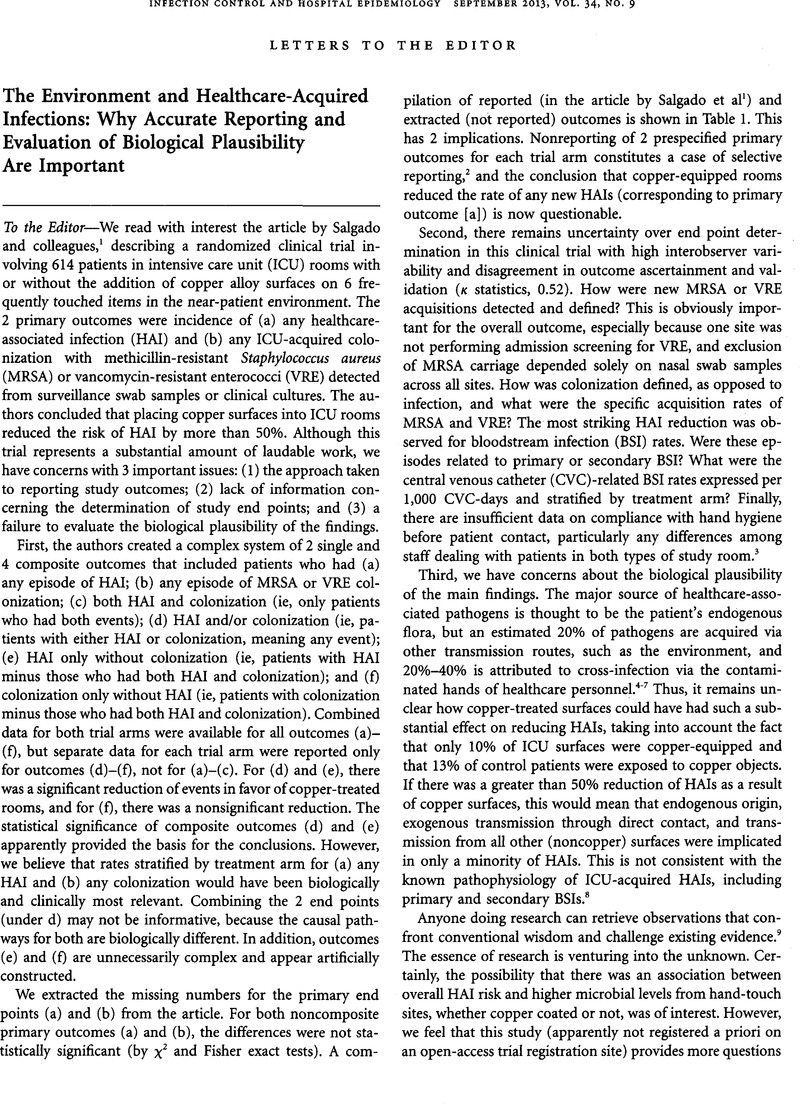Crossref Citations
This article has been cited by the following publications. This list is generated based on data provided by Crossref.
Salgado, Cassandra D.
Sepkowitz, Kent A.
John, Joseph F.
Cantey, J. Robert
Attaway, Hubert H.
Freeman, Katherine D.
Sharpe, Peter A.
Michels, Harold T.
and
Schmidt, Michael G.
2013.
Reply to Harbarth et al.
Infection Control & Hospital Epidemiology,
Vol. 34,
Issue. 9,
p.
997.
Dancer, Stephanie J.
2014.
Controlling Hospital-Acquired Infection: Focus on the Role of the Environment and New Technologies for Decontamination.
Clinical Microbiology Reviews,
Vol. 27,
Issue. 4,
p.
665.
Mann, Ethan E
Manna, Dipankar
Mettetal, Michael R
May, Rhea M
Dannemiller, Elisa M
Chung, Kenneth K
Brennan, Anthony B
and
Reddy, Shravanthi T
2014.
Surface micropattern limits bacterial contamination.
Antimicrobial Resistance and Infection Control,
Vol. 3,
Issue. 1,
Landelle, Caroline
Marimuthu, Kalisvar
and
Harbarth, Stephan
2014.
Infection control measures to decrease the burden of antimicrobial resistance in the critical care setting.
Current Opinion in Critical Care,
Vol. 20,
Issue. 5,
p.
499.
Otter, Jonathan A.
2014.
Use of Biocidal Surfaces for Reduction of Healthcare Acquired Infections.
p.
137.
Otter, Jonathan A.
Yezli, Saber
and
French, Gary L.
2014.
Use of Biocidal Surfaces for Reduction of Healthcare Acquired Infections.
p.
27.
Humphreys, H.
2014.
Self-disinfecting and Microbiocide-Impregnated Surfaces and Fabrics: What Potential in Interrupting the Spread of Healthcare-Associated Infection?.
Clinical Infectious Diseases,
Vol. 58,
Issue. 6,
p.
848.
Huttner, Benedikt D
and
Harbarth, Stephan
2015.
Hydrogen peroxide room disinfection – ready for prime time?.
Critical Care,
Vol. 19,
Issue. 1,
Otter, J.A.
2015.
What's trending in the infection prevention and control literature? From HIS 2012 to HIS 2014, and beyond.
Journal of Hospital Infection,
Vol. 89,
Issue. 4,
p.
229.
Kavanagh, Kevin T.
Tower, Stephen S.
and
Saman, Daniel M.
2016.
A Perspective on the Principles of Integrity in Infectious Disease Research.
Journal of Patient Safety,
Vol. 12,
Issue. 2,
p.
57.
Dancer, Stephanie J.
2016.
Dos and don’ts for hospital cleaning.
Current Opinion in Infectious Diseases,
Vol. 29,
Issue. 4,
p.
415.
Alvarez, Evelyn
Uslan, Daniel Z.
Malloy, Timothy
Sinsheimer, Peter
and
Godwin, Hilary
2016.
It is time to revise our approach to registering antimicrobial agents for health care settings.
American Journal of Infection Control,
Vol. 44,
Issue. 2,
p.
228.
Rock, Clare
Small, Bryce A.
and
Thom, Kerri A.
2018.
Innovative Methods of Hospital Disinfection in Prevention of Healthcare-Associated Infections.
Current Treatment Options in Infectious Diseases,
Vol. 10,
Issue. 1,
p.
65.
Chyderiotis, S.
Legeay, C.
Verjat-Trannoy, D.
Le Gallou, F.
Astagneau, P.
and
Lepelletier, D.
2018.
New insights on antimicrobial efficacy of copper surfaces in the healthcare environment: a systematic review.
Clinical Microbiology and Infection,
Vol. 24,
Issue. 11,
p.
1130.
Abbas, Mohamed
Pires, Daniela
Peters, Alexandra
Morel, Chantal M
Hurst, Samia
Holmes, Alison
Saito, Hiroki
Allegranzi, Benedetta
Lucet, Jean-Christophe
Zingg, Walter
Harbarth, Stephan
and
Pittet, Didier
2018.
Conflicts of interest in infection prevention and control research: no smoke without fire. A narrative review.
Intensive Care Medicine,
Vol. 44,
Issue. 10,
p.
1679.
Perencevich, Eli N.
Harris, Anthony D.
Pfeiffer, Christopher D.
Rubin, Michael A.
Hill, Jennifer N.
Baracco, Gio J.
Evans, Martin E.
Klutts, J. Stacey
Streit, Judy A.
Nelson, Richard E.
Khader, Karim
and
Reisinger, Heather Schacht
2018.
Establishing a Research Agenda for Preventing Transmission of Multidrug-Resistant Organisms in Acute-Care Settings in the Veterans Health Administration.
Infection Control & Hospital Epidemiology,
Vol. 39,
Issue. 2,
p.
189.
Abbas, M.
Pires, D.
Harbarth, S.
and
de Kraker, M.E.A.
2019.
Infection prevention: is copper the new gold?.
Journal of Hospital Infection,
Vol. 101,
Issue. 1,
p.
109.
Dancer, Stephanie J
2020.
How Much Impact Do Antimicrobial Surfaces Really Have on Healthcare-acquired Infection?.
Clinical Infectious Diseases,
Vol. 71,
Issue. 8,
p.
1814.
Dauvergne, Emilie
and
Mullié, Catherine
2021.
Brass Alloys: Copper-Bottomed Solutions against Hospital-Acquired Infections?.
Antibiotics,
Vol. 10,
Issue. 3,
p.
286.
Dancer, S.J.
and
Inkster, T.
2022.
One size does not fit all: why infection prevention is difficult to randomize or control.
Journal of Hospital Infection,
Vol. 123,
Issue. ,
p.
182.



